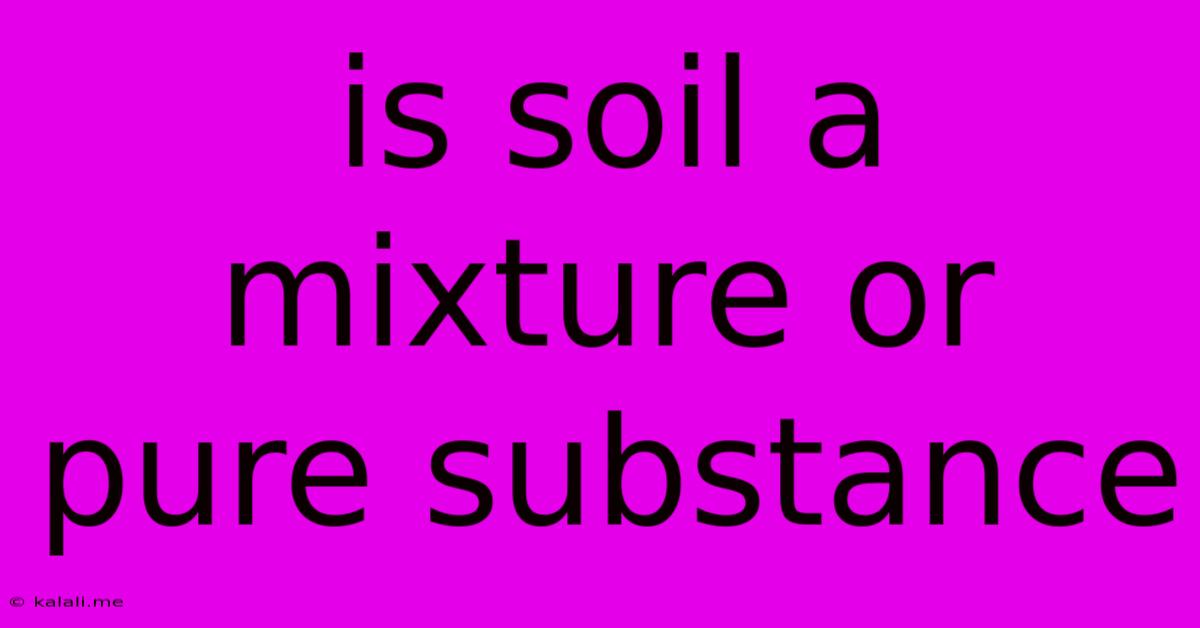Is Soil A Mixture Or Pure Substance
Kalali
May 09, 2025 · 3 min read

Table of Contents
Is Soil a Mixture or a Pure Substance? A Deep Dive into Soil Composition
Is soil a mixture or a pure substance? This seemingly simple question opens the door to a fascinating exploration of the Earth's complex and vital top layer. The answer, in short, is that soil is a heterogeneous mixture. This means it's composed of various substances that aren't chemically bonded together and aren't uniformly distributed throughout. Understanding this fundamental characteristic is key to appreciating soil's incredible diversity and its importance to life on Earth.
This article will delve into the composition of soil, explaining why it's classified as a mixture and exploring the different components that make up this incredibly dynamic system. We'll also touch upon the implications of soil's heterogeneous nature for agriculture, environmental science, and beyond.
The Defining Characteristics of Mixtures
Before we dive into the specifics of soil, let's quickly review the difference between a mixture and a pure substance. A pure substance has a fixed chemical composition and consistent properties throughout. Examples include pure water (H₂O) and table salt (NaCl). In contrast, a mixture is a combination of two or more substances that are not chemically bonded. Mixtures can be homogeneous (like saltwater, where the salt is evenly distributed) or heterogeneous (like a salad, where the ingredients are easily distinguishable).
Soil clearly falls into the latter category. A handful of soil reveals a complex tapestry of different materials, each with unique properties.
The Components of Soil: A Heterogeneous Blend
Soil is a dynamic system composed of several key components:
-
Mineral particles: These are the inorganic portion of soil, derived from the weathering of rocks. Different types of rocks yield different sized particles, ranging from large gravel to microscopic clay. The size and type of these particles significantly impact soil texture and drainage. Think of sand, silt, and clay as the building blocks of the mineral portion.
-
Organic matter: This includes decomposed plant and animal materials, providing essential nutrients and improving soil structure. Humus, a stable form of organic matter, is crucial for water retention and nutrient availability. The decomposition process itself is a complex series of chemical and biological reactions.
-
Water: Soil water is essential for plant growth, transporting nutrients and acting as a solvent for various chemical processes. The amount of water in soil varies greatly depending on factors like rainfall, drainage, and soil texture. Soil scientists often refer to field capacity and wilting point, reflecting the water content range vital for plant survival.
-
Air: Soil air fills the spaces between soil particles not occupied by water. It is crucial for the respiration of soil organisms, including the vital soil microbes that facilitate nutrient cycling. The air composition within the soil can differ from atmospheric air, often having higher carbon dioxide levels.
-
Living organisms: Soil teems with life, from microscopic bacteria and fungi to larger invertebrates and the roots of plants. These organisms play a critical role in nutrient cycling, decomposition, and soil structure development. The biotic community within the soil is incredibly diverse and complex.
Why Soil's Heterogeneous Nature Matters
The fact that soil is a heterogeneous mixture has profound implications:
-
Nutrient variability: The uneven distribution of organic matter and mineral particles results in variations in nutrient availability across the soil profile. This is a key consideration for precision agriculture techniques.
-
Water management: Soil texture and structure significantly influence water infiltration and drainage. Understanding this heterogeneity is critical for effective irrigation and preventing erosion.
-
Environmental remediation: The diverse composition of soil affects its ability to absorb and retain pollutants. This is crucial for understanding and mitigating environmental contamination.
In conclusion, soil is unequivocally a heterogeneous mixture, a complex interplay of mineral particles, organic matter, water, air, and living organisms. This inherent heterogeneity is not a flaw but rather a testament to soil's remarkable ability to support life and provide essential ecosystem services. Understanding this complexity is crucial for sustainable agriculture, environmental protection, and ensuring the long-term health of our planet.
Latest Posts
Latest Posts
-
What Is 59 Degrees Celsius In Fahrenheit
May 09, 2025
-
40 Is What Percent Of 70
May 09, 2025
-
16 12 As A Mixed Number
May 09, 2025
-
10 Is What Percent Of 90
May 09, 2025
-
Determine The Mass Of The Sun
May 09, 2025
Related Post
Thank you for visiting our website which covers about Is Soil A Mixture Or Pure Substance . We hope the information provided has been useful to you. Feel free to contact us if you have any questions or need further assistance. See you next time and don't miss to bookmark.